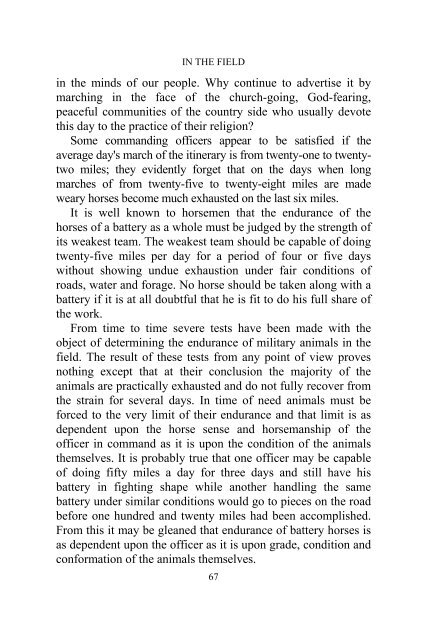the field artillery journal - Fort Sill - U.S. Army
the field artillery journal - Fort Sill - U.S. Army
the field artillery journal - Fort Sill - U.S. Army
Create successful ePaper yourself
Turn your PDF publications into a flip-book with our unique Google optimized e-Paper software.
IN THE FIELD<br />
in <strong>the</strong> minds of our people. Why continue to advertise it by<br />
marching in <strong>the</strong> face of <strong>the</strong> church-going, God-fearing,<br />
peaceful communities of <strong>the</strong> country side who usually devote<br />
this day to <strong>the</strong> practice of <strong>the</strong>ir religion?<br />
Some commanding officers appear to be satisfied if <strong>the</strong><br />
average day's march of <strong>the</strong> itinerary is from twenty-one to twentytwo<br />
miles; <strong>the</strong>y evidently forget that on <strong>the</strong> days when long<br />
marches of from twenty-five to twenty-eight miles are made<br />
weary horses become much exhausted on <strong>the</strong> last six miles.<br />
It is well known to horsemen that <strong>the</strong> endurance of <strong>the</strong><br />
horses of a battery as a whole must be judged by <strong>the</strong> strength of<br />
its weakest team. The weakest team should be capable of doing<br />
twenty-five miles per day for a period of four or five days<br />
without showing undue exhaustion under fair conditions of<br />
roads, water and forage. No horse should be taken along with a<br />
battery if it is at all doubtful that he is fit to do his full share of<br />
<strong>the</strong> work.<br />
From time to time severe tests have been made with <strong>the</strong><br />
object of determining <strong>the</strong> endurance of military animals in <strong>the</strong><br />
<strong>field</strong>. The result of <strong>the</strong>se tests from any point of view proves<br />
nothing except that at <strong>the</strong>ir conclusion <strong>the</strong> majority of <strong>the</strong><br />
animals are practically exhausted and do not fully recover from<br />
<strong>the</strong> strain for several days. In time of need animals must be<br />
forced to <strong>the</strong> very limit of <strong>the</strong>ir endurance and that limit is as<br />
dependent upon <strong>the</strong> horse sense and horsemanship of <strong>the</strong><br />
officer in command as it is upon <strong>the</strong> condition of <strong>the</strong> animals<br />
<strong>the</strong>mselves. It is probably true that one officer may be capable<br />
of doing fifty miles a day for three days and still have his<br />
battery in fighting shape while ano<strong>the</strong>r handling <strong>the</strong> same<br />
battery under similar conditions would go to pieces on <strong>the</strong> road<br />
before one hundred and twenty miles had been accomplished.<br />
From this it may be gleaned that endurance of battery horses is<br />
as dependent upon <strong>the</strong> officer as it is upon grade, condition and<br />
conformation of <strong>the</strong> animals <strong>the</strong>mselves.<br />
67

















